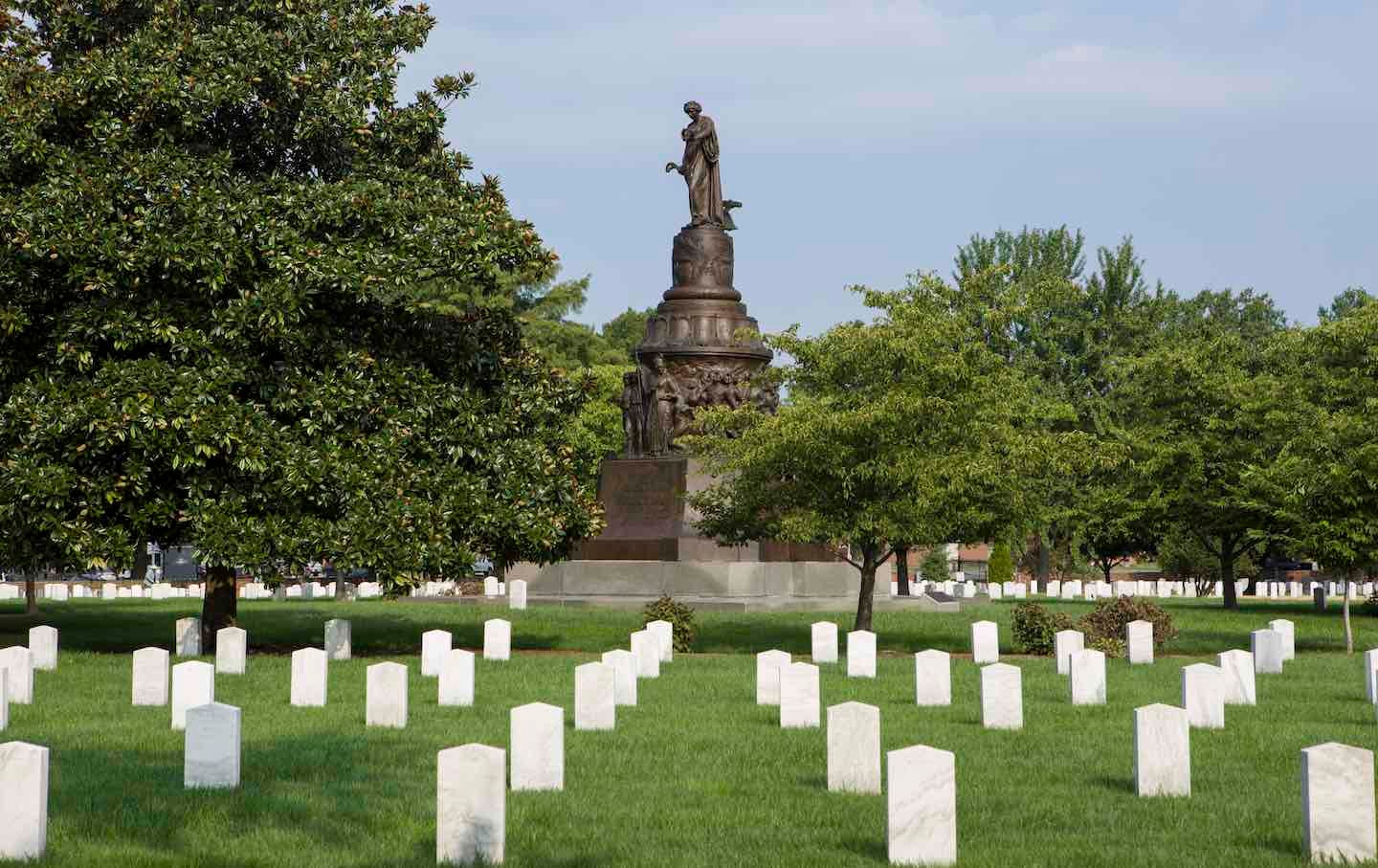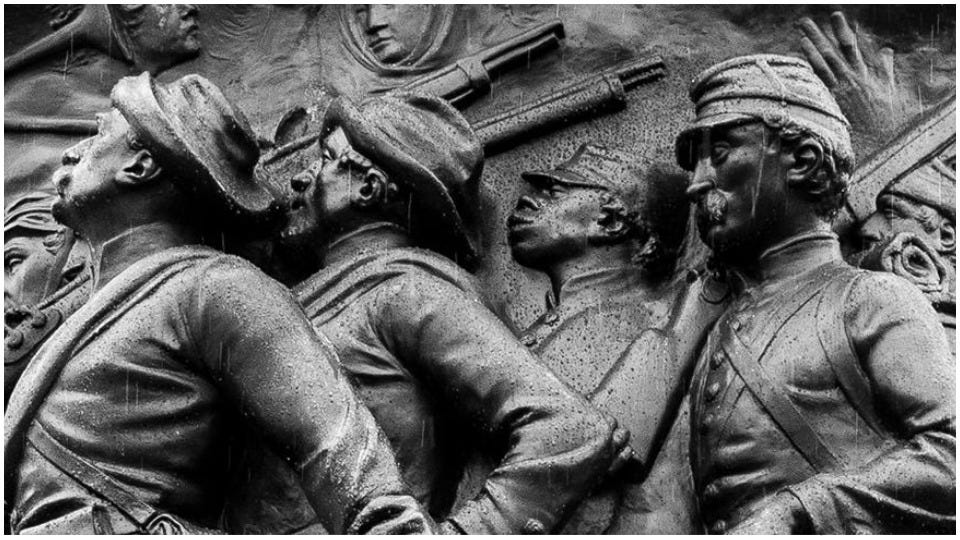Jim Webb, former Virginia senator and Navy Secretary, has weighed in on the decision to remove the Confederate monument in Arlington National Cemetery. My response to Webb’s op-ed is not focused on the question of whether the monument should be removed, but on his understanding of the monument’s history and Civil War memory.
Like other defenders of the monument, Webb views this monument as a symbol of reunion/reconciliation—in his words, an attempt to “mend a generation’s sectional divide.” He sets this out in the opening paragraph:
In 1898, 33 years after the end of the Civil War, the Spanish-American War brought a sudden, unanticipated harmony and unity to a country that had been riven by war and a punitive postwar military occupation, which failed at wholesale societal reconstruction. In the South, American flags flew again as the sons of Confederate soldiers volunteered to fight, even if it meant wearing the once-hated Yankee blue. President William McKinley presciently seized this moment to mend a generation’s sectional divide.
McKinley did this, in part, by calling for the nation to take better “care of the graves of the Confederate soldiers.” It would be a mistake to ignore the politics of the moment. The nation had proved victorious in the Spanish-American War and was now one of the dominant powers on the world stage. McKinley had both domestic and international goals that he hope to achieve and would need southern support. This is not to discount his call to care for Confederate graves, but to remind us that Civil War memory has always been rooted in the politics of the moment.
More importantly, we need to acknowledge a distinction between the plan to rebury Confederates at Arlington and the monument that would eventually be dedicated in Section 16. There is no question that some people envisioned a commemorative object for the space, but no one had any idea what it would look like. In other words, we can and should acknowledge the sentiments of reunion that were expressed surrounding the Confederate dead and any evaluation of the monument, which came much later.
The other thing that we need to remember is that from the beginning there was deep disagreement as to whether Confederates should be buried in their own section at Arlington. Union veterans were opposed to the decorating of the few Confederate graves that existed in Arlington in the years following the war. They even went as far to call for the banning of family members from visiting these graves. Even the United Daughters of the Confederacy initially came out against this plan. Many white southerners believed that Confederates should not be buried in sight of Union veterans, especially once objections to the plan were expressed.
Groups like the Ladies Memorial Association were already hard at work on trying to remove the scattered Confederates buried at Arlington, so they could be properly honored on “southern soil.”
In Richmond, Virginia organizations rallied to remove their Confederate dead to Hollywood Cemetery in response to the very clear objections voiced by Union veterans through the Grand Army of the Republic over the reburial plan.
The point is that the “sectional divide” that McKinley and others hoped to “mend” was never fully achieved. Despite the completion of the burials by 1906 and the dedication of the monument in 1914, the generation that fought the war remained deeply divided over the war. Reconciliation was more a dream or aspiration and never a reality.
To the extent that reconciliation was achieved or experienced at specific moments, it came at the price of the nation’s Black population. By the turn of the twentieth century, legalized segregation was spreading across the country through the rewriting of state constitutions and the violence that would come to define the Jim Crow era.
At Arlington National Cemetery, Black soldiers remained buried in a segregated area known as Section 28. Even today, few people visit what was once known as the “Lower Cemetery.”
Webb never himself refers specifically to reunion and reconciliation, but the sentiment is present in his op-ed.
Anyone interested in the subject of Civil War memory should start their reading with Caroline Janney’s book, Remembering the Civil War: Reunion and the Limits of Reconciliation. Janney makes a very helpful distinction early in the book between reunion and reconciliation.
Reunion, according to Janney had been the goal of the war for the vast majority of the loyal citizenry of the United States. In short, reunion was a fact. “Reconciliation was harder to define, subject to both multiple and changing interpretations.” Demonstrations of reunion did not necessarily imply reconciliation among one-time enemies.
Union and Confederate veterans who attended the 1913 reunion at Gettysburg, for example, may have taken part in the performance of reunion by embracing one another over the stone wall, but that did not mean they were reconciled.
At no time during this period did the nation coalesce around one memory of the Civil War. They were always in tension with one another. This was true of the dedication of the Arlington monument as well.
Charles Francis Adams may have praised Robert E. Lee as part of a ceremony marking the centennial of his birth in 1907, but for the veterans in the G.A.R. the former Confederate general would forever be remembered as a “traitor” to the nation.
The problem with Webb’s understanding Civil War memory is that he uses the reburial of Confederates at Arlington to draw a conclusion about the state of sectional tensions. This blatant form of reductionism ignores the complexity of the situation.
Even more problematic is the fact that Webb has no understanding of the hsitory of the Confederate monument itself. Instead of dealing with the rich motifs that define the monument, Webb gets sidetracked with trying to show that Confederates were not fighting to defend the instituion of slavery.
Many soldiers in the North, and many more in the South, would have understood what John Hope Franklin (1915-2009), America’s most esteemed black historian, pointed out: In 1860 only 5% of whites in the South owned slaves, and less than 25% of whites benefited economically from slavery. An estimated 258,000 Confederate soldiers died in the war, about a third of all those who fought for the South. Few owned slaves. So why did they fight?
I find it curious that he would reference a Black historian here, but even more troubling is that Webb fails to acknowledge that the monument itself is a defense of slavery. It couldn’t be any clearer.
The two motifs, one showing a Confederate officer handing his child to an enslaved woman and the other a “body servant” or camp slave marching off with Confederate soldiers, constitutes what was acknowledged at the time as a defense of the institution of slavery.
Of course, it was a memory of slavery steeped in myth, in part, made possible by the fact that United States Colored Troops were buried in a segregated section of Arlington National Cemetery.
As historians Karen Cox, Micki McKelya, and other historians will tell you, the United Daughters of the Confederacy—who oversaw the construction and dedication of this monument—was never in the business of reconciliation and the healing of sectional tensions.
Their goal was ensuring that the Confederacy and Confederate soldiers specifically were remembered correctly, according to their own set of beliefs. Monument dedications, along with censoring history textbooks, was part of a broader project of controlling history.
The Confederate monument in Arlington is an unapologetic celebration and vindication of the Confederacy and its cause and that is exactly what the UDC intended.
Again, it is absolutely essential that we draw a distinction between the reburial of Confederates at Arlington and the monument.
Mr. Webb has every right to call for the monument to remain in its current location, but he also has a responsibility to honestly and accurately acknowledge its meaning, which was never intended to be hidden. It’s the second tallest memorial in the entire cemetery.
If he believes that a monument that celebrates the Confederacy as a noble cause and believes that its defense of slavery (as depicted on the monument itself) was laudable, in a cemetery that includes tens of thousands of white and Black soldiers who gave their lives in defense of the Union and helped to end the institution of slavery, then just say so.











Shorter “Reconciliation”, from an ex-Confederate perspective:
Ex-Cons: northerners have to agree with us and admit that we were right and morally superior; in exchange, we’ll agree to never shut up about it.
(Webb’s take on slavery as motivation is infuriating , but continues a WSJ tradition of utterly misunderstanding 1860s racial politics and it’s misuse of evidence.)
Kevin,
Thank you for this excellent article. I saw Webb’s op-Ed and had the same thoughts as you. I would have written about it citing much of what you said , but I would not have been able to shed as much light on it as you did, this was outstanding work. Thank you. I have been backed up with my Dan Sickles series which grew on me forcing me to do a lot more research. I want to finish it before the final year of my doctoral program heats up on Monday.
All the best and thank you for this outstanding piece. Faugh A Ballahg!
Peace,
Steve+